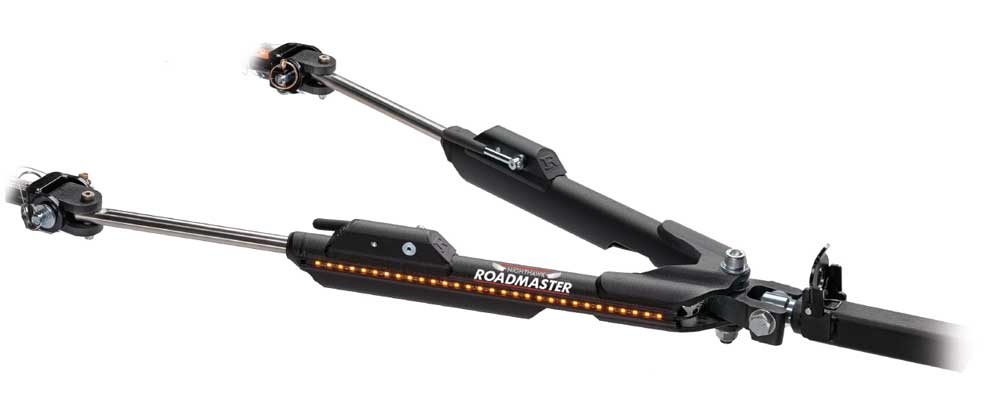It’s time to brush up on tow bars and learn which one is right for your needs and budget
In last month’s inaugural Dinghy Digest column, we presented the importance of baseplates and how to choose them. In this installment, we’re covering the key component for pulling a dinghy vehicle safely: the tow bar.
Though there’s no official history from which to draw, we do know that tow bars started out rather humbly, as steel A-frames that were likely fabricated in the 1970s at a welding shop or trailering center. Hey, someone had to be first, right? But as components for every industry tend to do, tow bars gradually evolved and got stronger, lighter and more versatile, not to mention more convenient to handle once the dinghy is disconnected.
Today, there are still legacy designs that will get the job done, but the latest models incorporate stainless steel and aluminum and can handle 10,000 pounds or more. Choosing the right one — especially for newbies — can be challenging, so let’s break it down.
Budget versus Features
Obviously, the level of tow bar is based on budget, but choosing a model that can handle the weight of the dinghy vehicle is of critical importance. All of the tow bars on the market today are rated for at least 5,000 pounds, which covers just about every passenger car out there — so from a capability standpoint, even the tow bars with minimum frills will do the job. When towing a larger, heavier vehicle like a pickup, however, the weight capacity of the bar should be the primary concern.

Made from aircraft-grade aluminum, the Blue Ox Ascent tow bar weighs 31 pounds and has a 7,500-pound weight capacity. The Ascent’s off-set triple lugs, self-aligning legs and non-binding latches make unhooking easy, even if the vehicle is parked on an unlevel surface.
Blue Ox | 800-228-9289
The next consideration should be the features. At the most basic level, these are pretty limited, but even here you may want to decide, for example, if you want a folding bar that is mounted (and can be stored) on the dinghy vehicle or one that folds and remains in the motorhome’s hitch receiver. The next thing you may want to consider when comparing apples-to-apples is the physical weight of the tow bar. While it’s true that the tow bar will spend the majority of its time either mounted to the car or the motorhome, you will still have to wrestle with it once in a while, so you’ll probably want the lightest model possible.
Although higher-end tow bars are generally more expensive, they are also feature-rich. Consideration should be given to the process of connecting/disconnecting the dinghy with little effort. As their name would imply, so-called “non-binding” tow bars won’t bind up on uneven ground, which makes connecting/disconnecting in rough terrain easier.

The 7,500-pound rated Demco Dominator tow bar incorporates steel and aluminum components into its modular design and weighs 30 pounds. Vinyl-covered safety clips keep the safety cables from dragging, and a standard 1½-inch rise/drop receiver helps compensate for height differences between the motorhome and dinghy vehicle.
Demco Products | 800-543-3626
Independently extendable arms allow you to connect the dinghy vehicle even if it is not lined up perfectly behind the motorhome. Safety-cable management is also important, and models that incorporate routing can streamline the process. Tow bars that remain attached to the motorhome eliminate the chances of damage should sloppy drivers back into a dinghy vehicle that is parked.

The Nighthawk is Roadmaster’s newest tow bar, rated at 8,000 pounds. Aluminum outer arms incorporate channels for the safety cables and power cord, as well as embedded LED lights that make the bar visible at night. Stainless-steel inner arms are the longest available, according to the company, and non-binding Freedom latches make it easy to connect/disconnect.
Roadmaster Inc. | 800-669-9690
When choosing a bar, it’s also important to think ahead: Will you want to use some kind of vehicle-protection device, like a shield or a screen? Most protective devices are proprietary and are not interchangeable among various brands, so you’ll probably want to decide which manufacturer offers the features, benefits and accessories you want, and stick with that brand.
There are more finite details than we have room to discuss here, so be sure to visit each company’s website for additional information on the various tow bars available to enthusiasts who tow a vehicle behind their motorhome.

